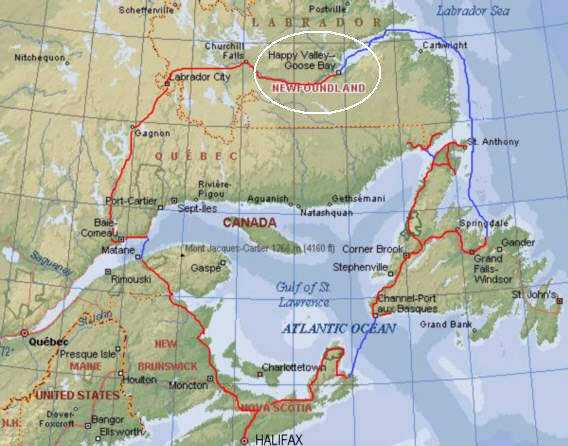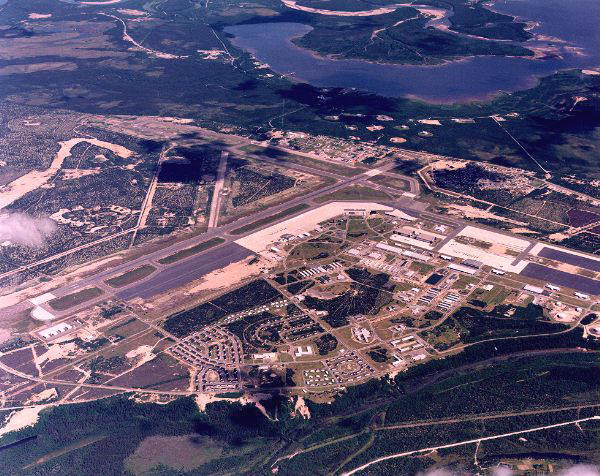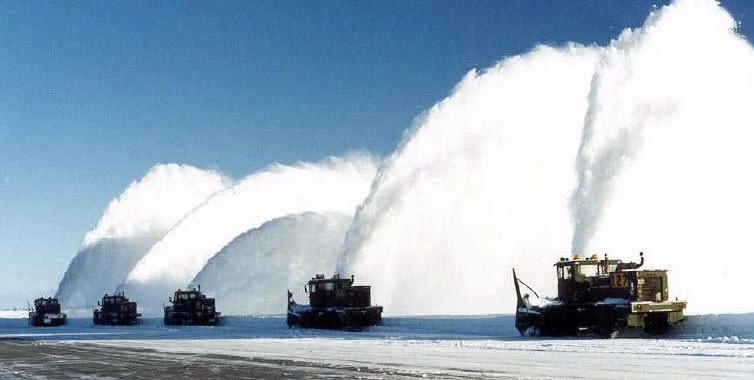| SAC Bases: Goose
Bay Air Base |
|
|

|
|
|
Goose Bay, affectionately known as "The Goose", is located in Canada's far
north. Labrador is the largest geographical portion of the province of
Newfoundland, covering 294,330 square kilometers with a population of just
over 30,000. At one time, it was home to SAC's 95th Strategic
Wing.
Air Force Combat Wing Histories (official
USAF history) states that the 95th Bomb Wing Medium was established June 4,
1952 and activated on June 16. It was redesignated 95th Bomb Wing
Heavy on Nov. 8, 1952. Apparently it was originally slated for
B-47s, but was instead assigned B-36s, which it flew from 1953 to 1959.
It flew B-52s from 1959 to 1966. It was discontinued and
inactived on June 25, 1966. All of this took place at Biggs AFB,
Texas.
It was reactivated as the 95th Strategic Wing on
August. 8, 1966 at Goose Bay. At that time, the wing was flying KC-135
tankers. It was inactivated on September 30, 1976. This
conflicts with several web sites that report that was home of the 95th
Strategic Wing from the early 1950s to 1976. That is wrong. |
|
 |
The
decision to build the base was made early in World War II.
Toward helping our British friends defends themselves the threat of Nazi
German, the United States and Great Britain entered into a
"Lend-Lease" agreement. The U.S. gave Britain fifty Word War I
destroyers in exchange for eight strategic military locations in the
Atlantic and Caribbean. One of these locations became Goose Air Base
in Labrador.
The site for the
base was selected in the summer of 1941 by Eric Fry, who was on loan to the
Royal Canadian Air Force from the Canadian Department of Mines and
Resources, and was approved by the Canadian Government shortly thereafter.
To bring men and supplies to the site dock facilities were built at
Terrington Basin, which is located at the western end of Goose Bay.
Construction of the base progressed rapidly and by November 16, 1941 three
7,000 foot runways were completed. On December 9th of that year, the first
military aircraft landed at the base. By 1942 there were 1,700 service
personnel and 700 civilians at the base, and in 1943 the airport there was
the largest in the world. The base, which had been built by the Canadian
Government as part of its contribution to the war effort, was also shared by
the United States and Great Britain. It was used as a refueling and shuttle
stop for overseas flights throughout the war. In the twelve-month period
ending in September 1945 the airfield handled over 24,000 aircraft. It
also served as a maritime patrol base. The town of Happy Valley
developed in 1943 to house the workers who came to build the Air Base
The Americans remained at Goose Bay after the war. In
1950 it became part of the Northeast Air Command
The Melville Radar Station. was finished in November 1954. The unit which
was perched atop a prominent hill six miles northwest of the airfield, was a
totally self contained facility with fire/rescue, messes, quarters and even
a bowling alley. The USAF's 641st AC&W Squadron, part of Pepperrell AFB, St.
John's, Newfoundland based 64th Air Division (Defense), took up residence
the same month. NEAC was deactivated 1 April 1957 and replaced by the 64th
Air Division; however, all NEAC assets were split up between Strategic Air
Command and Air Defense Command. The base was also used by the Royal
Air Force (R.A.F.) and the Royal Canadian Air Force (R.C.A.F.). The radar
station at Goose Bay was an integral part of the North American Air Defense
Command.
RCAF Station Goose Bay gave way to unification in 1967
and became a Canadian Forces Base. CFB Goose Bay was soon relegated to
station status. On 1 September 1970, a group of 30 Canadian Forces personnel
were posted to Goose Bay, where they ran the Manual NORAD Control Centre
(MNCC). The USAF Commander of the 641st AC&W Squadron handed the MNCC over
to the commanding officer of CFS Goose Bay in July 1971. It became site
C-24, and integrated into Canadian Forces Air Defence Command. Melville Long
Range Radar was now a lodger unit of CFS Goose Bay. After all the years as a
manually operated site, Melville Radar, as it was better known by, was
finally SAGE-capable in 1976. This automation considerably reduced the
number of personnel assigned to the site. In August 1984, Melville Radar was
brought into the Canada East ROCC. In 1985 the radar station acted as a
tactical control agency in a series of low level flying proof of concept
flights with NATO allies. In February 1988, the closure of Melville Radar
was announced. The reason given was that the station was redundant with the
North Warning System site, located at Cartwright, coming on line. The radar
site ceased operations in July 1988.
|
 |
During SAC's
tenure, over 12,000 American military personnel and family members lived on
the base. The far northern location resulted in long, very-cold
winters. It was not the most desirable duty. Some say it was the
origin of the expression, "Up Goose Creek without a paddle."
The two settlements of Happy Valley and Goose Bay
were amalgamated into a single town in 1974 and together the residents in
this wage-based economy have faced hard times as the management of the base
changed hands. The town has grown to be the largest centre in Labrador with
over 8,600 resident. The majority of retail and service businesses in this
area support the operation of the Air Base.
Today the base house Canadian forces, but also four others,
earning it the distinction of the 5 Wing Goose Bay. There are wings
from Britain's Royal Air Force, the German Luftwaffe, the Royal Netherlands
Air Force and the Italian Aeronautic Militare. Who in 1940 would
have ever thought the RAF and Luftwaffe would someday share an air base?
There are also civilian airlines.
Even though the economy is based on
earning, many residents with Innu, Inuit, Metis and settler heritage still
live the traditional Labrador lifestyle using their knowledge of living "off
the land." Many families depend on the caribou hunt, fishing and trapping of
small game to supplement their diets. A small manufacturing sector is
developing in Central Labrador, along with a few small agricultural
initiatives in the past 10 years.
Goose Bay has one of the world's longest runways
(11,046 feet.) It is long enough to accommodate the space shuttle and
is a NASA designated emergency landing site for space shuttle flights. In
fact, the Boeing 747 carrying the space shuttle landed for refueling in
1983. That was the first time a space shuttle touched down anywhere except
only US soil.
Following the terrorists attacks of September 11,
2001, the Goose Bay Base was filled with commercial airliners that had been
diverted from their planned destinations. |
|

|
|
